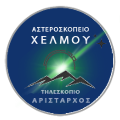Helmos Observatory iniTiateS oPtical cOmmunicaTions
(HOTSPOT)
a contract between the European Space Agency and the National Observatory of Athens under the
OPERATIONS DEVELOPMENT SUPPORT FOR OPTICAL AND QUANTUM GROUND INFRASTRUCTURE (ARTES 4.0 SL SPL 6C.031) – EXPRO+
funding scheme
Helmos Observatory was selected by ESA to become the first Optical Ground Station (OGS) to operate under the ScyLight framework. During the last period, NOA staff have been working in close collaboration with ESA to develop the necessary equipment and to upgrade the 2.3 m Aristarchos telescope for optical communication activities. The instrumentation that has already been developed needs to be installed and properly tested before it can be used for satellite operation campaigns. Furthermore, missing items for further developments (e.g. for Quantum Communication, Deep Space Optical Communication) need to be identified and listed for future developments. Under the framework of this contract, the NOA staff will support reception of software and hardware, will identify the items required for further activities related to optical communications, will assist in mounting the new instruments on the telescope and perform any necessary actions to ensure functionality and safety, and will perform tests and report results on satellite campaigns.

Objectives of HOTSPOT
The objective of this study is to identify all possible activities that can be supported at Helmos observatory in Greece under the ScyLight framework and to detail the support and the operational readiness in conducting satellite test campaigns. NOA owns and operates Helmos Observatory, which was selected as the first OGS under the ScyLight framework.
The need of using optical communications
Optical communications are expected to increase the data-rates up to a factor of 100 compared with the existing RF technology. Furthermore this technology is ideal for satellites since it consumes less power, needs less space and devices are less massive. Furthermore, laser communications do not suffer from interference, like RF links do, given the very concentrated laser beams compared to RF. Helmos Observatory can be transformed to an ideal test-bed facility for optical communication links.
Helmos Observatory
Helmos Observatory is situated on Neraidorachi, a mountaintop of the Helmos mountain chain in the Peloponnese, Greece, at an altitude of 2340 m above sea level, 220 km west of Athens. Helmos Observatory hosts the Aristarchos 2.3 m telescope, an optical telescope designed and manufactured by the German company Carl Zeiss GmbH ). Recently, in 2020, the Aristarchos telescope was selected by ESA to be the first Optical Ground Station of the European program for the next generation of telecommunications services “fibre in the sky” and the dedicated element for optical communications, photonics and quantum communication, called ScyLight.
The facilities at Helmos Observatory can be used to perform various experiments in the field of optical communications. The large aperture combined with excellent atmospheric seeing conditions of the site, makes Aristarchos a valuable asset for optical communications and quantum key distribution (QKD) and especially suited for lunar, Lagrange orbit and deep space communications.
Helmos Observatory is ideally suited to support optical communication links in the framework of ESAs HydRON project. A set of instruments, designed specifically for Aristarchos by ESA, have already been developed by ESA and are ready to be implemented at the telescope and thoroughly tested for optical communications. In parallel with the hardware development, dedicated software for autonomous satellite tracking and related operations of the telescope is being developed.

Helmos Observatory is intended to become one of the Greek nodes in the EU’s proposed quantum communications infrastructure, called EuroQCI. Since 2019, ESA has been working with the European Commission to implement the space segment of the EuroQCI initiative via its SAGA program. The Helmos OGS will play an important role for Quantum Key Distribution (QKD) as well as Deep Space Optical Communications (DSOC) experiments, because its large aperture diameter enables reception of unprecedented quantities of key material from satellites.
The well experienced NOA staff will undertake the reception of the already developed equipment and update the inventory of all items required for this activity. The OGS operators will also be trained by ESA experts on the use of the equipment and perform satellite test campaigns.
